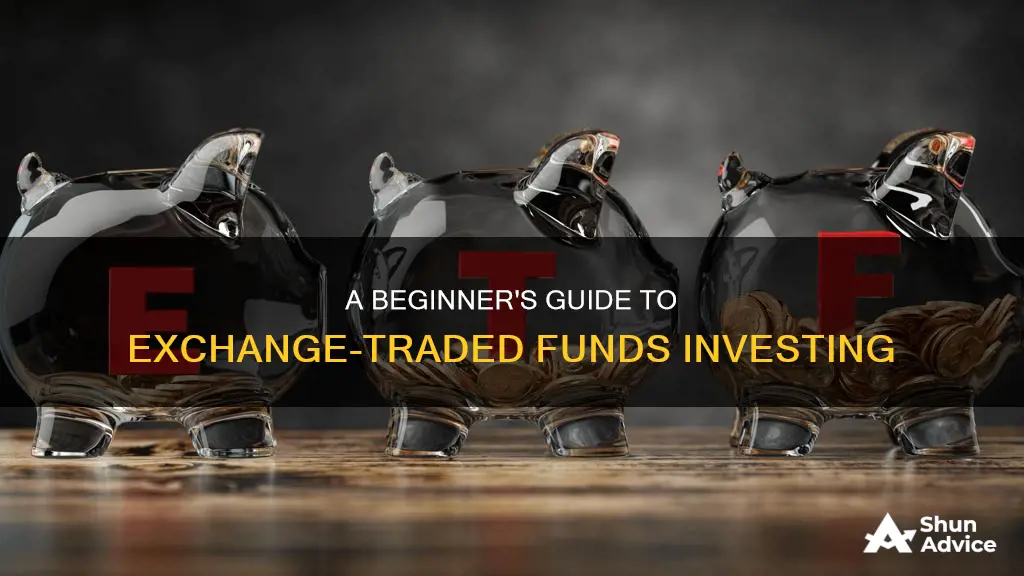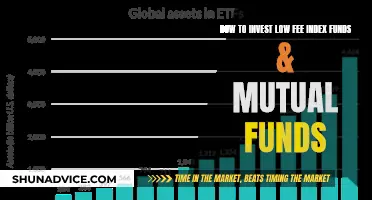
Exchange-traded funds (ETFs) are a great way to get started with investing. They are simple to understand, can generate impressive returns, and are easy to buy and sell. ETFs are also a good option for investors who want to gain exposure to a variety of stocks, bonds, and other assets without incurring high expenses.
ETFs are essentially index funds that are listed and traded on exchanges like stocks. They are a basket of stocks, bonds, or commodities that reflect the composition of an index, such as the S&P 500 or the Nasdaq-100. The trading value of an ETF is based on the net asset value of the underlying stocks or commodities it represents.
One of the key benefits of ETFs is that they provide broad diversification with liquidity at a lower cost compared to other forms of investing. They are also more liquid and easier to buy and sell than mutual funds.
When investing in ETFs, it is important to consider the expense ratios, which are the fees charged by the ETF, and to be aware of any potential tax implications. Additionally, it is crucial to open a brokerage account and choose the right ETFs that align with your investment goals and risk tolerance.
Overall, ETFs are a great option for beginners and experienced investors looking for a low-cost, diversified investment option.
| Characteristics | Values |
|---|---|
| Definition | Exchange-traded funds (ETFs) are a type of index fund that can be traded like an individual stock on an exchange. |
| How to Trade | ETFs can be bought and sold through online brokers, traditional broker-dealers, robo-advisors, or retirement accounts. |
| Investment Vehicles | ETFs differ from mutual funds in that they are bought and sold like stocks, and are therefore more liquid. |
| Investment Style | Passive ETFs aim to replicate the performance of a broader index, while actively managed ETFs hire portfolio managers to make investment decisions. |
| Fees | ETFs charge fees, known as the expense ratio, which is listed as an annual percentage. |
| Dividends | Most ETFs pay dividends, which can be paid as cash or reinvested through a dividend reinvestment plan. |
| Taxation | ETFs in a standard brokerage account may result in taxable income from capital gains and dividends. |
| Investment Amount | ETFs don't have minimum investment requirements, but trade on a per-share basis. |
| Advantages | ETFs provide exposure to a variety of stocks, bonds, and other assets at a low expense, with the benefit of diversification. |
| Disadvantages | ETFs have less return potential than individual stocks, and may be subject to commission fees. |
What You'll Learn

How to choose an Exchange-Traded Fund (ETF)
When choosing an Exchange-Traded Fund (ETF), there are several factors to consider. Here are some key points to help you make an informed decision:
- Investment Objective: Determine your investment goals and risk tolerance. Choose ETFs that align with your objectives and help you achieve your desired asset allocation.
- Diversification: ETFs offer instant diversification by providing exposure to a wide range of asset classes, including stocks, bonds, commodities, and more. Consider ETFs that invest in multiple sectors or countries to further diversify your portfolio.
- Fees and Expenses: ETFs are known for their low fees, but these can vary among providers. Compare the expense ratios, commission fees, and other associated costs before selecting an ETF.
- Performance and Track Record: Evaluate the historical performance of the ETF to get an idea of its potential returns. Look at how closely it tracks its underlying index or asset and analyse its performance relative to similar ETFs.
- Liquidity and Trading Volume: Opt for ETFs with higher trading volumes as they tend to be more liquid, making it easier to buy and sell shares without significantly impacting the price.
- Provider and Reputation: Consider the reputation and track record of the ETF provider. Research their management style, investment strategies, and how their other ETFs have performed over time.
- Tax Efficiency: ETFs are generally considered tax-efficient due to their structure. However, it's important to understand the tax implications for the specific ETF you're considering, especially if you're investing in a taxable account.
- Minimum Investment: While ETFs typically have low minimum investment requirements, some may require a higher initial investment. Ensure you meet the minimum investment threshold for the ETF you're interested in.
- Specialty ETFs: Depending on your investment goals, you may want to explore specialty ETFs such as sector-specific, thematic, or actively managed ETFs. These can provide targeted exposure to specific industries, trends, or investment strategies.
- Brokerage Account: Choose a brokerage platform that offers a wide range of ETF options and aligns with your investment needs. Some brokers may offer commission-free trading for certain ETFs, so consider this when selecting a platform.
Remember, it's essential to conduct thorough research and due diligence before investing in any ETF. Diversification and asset allocation do not ensure profit or protect against losses. Carefully consider your investment objectives and risk tolerance before investing.
M1 Finance: Invest in One Fund for Easy Diversification
You may want to see also

Understanding ETF basics
Exchange-traded funds (ETFs) are index funds that are listed and traded on exchanges like stocks. They are a basket or collection of stocks, bonds, or commodities that reflect the composition of an index, such as the S&P 500 or BSE Sensex. ETFs can also be designed to track specific investment strategies, such as income generation or risk hedging. The first ETF was the SPDR S&P 500 ETF (SPY), which tracks the S&P 500 Index.
ETFs are bought and sold like individual stocks on an exchange, and their share prices fluctuate throughout the day as they are traded. They offer investors low expense ratios and fewer broker commissions compared to buying individual stocks. Additionally, ETFs must be registered with the Securities and Exchange Commission (SEC) and are subject to regulatory requirements.
There are two main types of ETFs: passive and active. Passive ETFs, also known as index funds, track a stock index like the S&P 500, aiming to match its performance. On the other hand, active ETFs hire portfolio managers to invest their money with the goal of beating the index's performance. Active ETFs tend to be more expensive than passive ETFs.
When investing in ETFs, it is important to understand their expense ratios, which represent the fees charged by the fund as a percentage of your investment. For example, a 1% expense ratio means you pay $10 in fees for every $1,000 invested. ETFs also pay dividends, which can be received as cash or automatically reinvested through a dividend reinvestment plan (DRIP).
ETFs are a great option for beginners as they are simple to understand, provide exposure to a variety of stocks and bonds, and offer impressive returns without requiring much expense or effort. They are also more liquid and easier to buy and sell than mutual funds.
The Rich Avoid Index Funds: Why?
You may want to see also

Understanding ETF taxes
Exchange-traded funds (ETFs) are considered more tax-efficient than mutual funds due to their structure. They create and redeem shares using in-kind transactions, which aren't considered sales and, therefore, don't trigger taxable events. This is based on a section of the US Internal Revenue Code of 1986, which exempts the distribution of capital gains when the shares that have appreciated in value are given to redeeming investors.
However, selling your shares in an ETF is a taxable event. Whether you have a long-term or short-term capital gain or loss depends on how long you've held the shares. In the US, you need to hold an ETF for more than a year to benefit from any sale being treated as long-term capital gains. If you hold it for a year or less, it's considered a short-term gain, typically resulting in a higher tax rate.
ETFs are also subject to the wash sale rule, which means that if you sell an ETF and buy the same or a substantially similar ETF after less than 30 days, the loss can't be used to offset other capital gains. Instead, the disallowed loss is added to the cost basis of the new securities purchased, delaying any tax benefits until the replacement security is sold.
Additionally, high earners may be subject to the 3.8% net investment income tax on ETF sales.
ETFs that invest in currencies, metals, and futures have specific rules and are usually taxed as short-term gains.
When it comes to dividends and interest payments from ETFs, these are taxed like income from the underlying stocks or bonds they hold. For US taxpayers, this income needs to be reported on Form 1099-DIV.
In summary, while ETFs offer tax advantages over mutual funds due to their structure and lower capital gains taxes, it's important to understand the specific tax rules and strategies to optimise your tax liability when investing in ETFs.
Hedging Mutual Fund Investments: Strategies for Risk Mitigation
You may want to see also

How to start investing in ETFs
Exchange-traded funds (ETFs) are a collection of stocks and bonds in a single fund, giving investors access to hundreds of stocks in one fund at very low fees. ETFs are similar to mutual funds but are bought and sold on stock exchanges, can be traded anytime the exchange is open, and have a lower investment threshold. ETFs are also easily traded on the stock exchange, bought and sold throughout the trading day, and their share price can fluctuate above or below their net asset value (NAV) based on supply and demand.
- Open a brokerage account: Before you can buy or sell ETFs, you need to open a brokerage account. You can do this online, and many brokers have no account minimums, transaction fees, or inactivity fees.
- Choose your first ETFs: For beginners, passive index funds are generally the best option. Index funds are cheaper than actively managed funds, and most actively managed funds don't beat their benchmark index over time.
- Let your ETFs do the hard work for you: ETFs are generally designed to be maintenance-free investments. Avoid checking your portfolio too often and making emotional, knee-jerk reactions to major market moves.
Tips for beginners:
- Before investing your money, try your hand at a practice portfolio to help you better understand the investment process. Most online brokers provide practice accounts where you can learn about ETF investing without risking your actual savings.
- If you're new to ETF investing, it's important to understand the costs involved, including brokerage fees and ETF management fees.
- ETFs are generally considered safer to own than individual stocks because they provide the benefits of diversification.
Smart Mutual Fund Investing with 3 Lakhs
You may want to see also

ETF advantages and disadvantages
Advantages of Exchange-Traded Funds (ETFs)
- ETFs are considered low-risk investments because they are low-cost and hold a basket of stocks or other securities, increasing diversification.
- ETFs tend to have much lower expense ratios compared to actively managed funds.
- They can be more tax-efficient and offer the option to immediately reinvest dividends.
- They trade like stocks, meaning you can trade them anytime during market hours.
- They are very versatile, letting you easily move money between specific asset classes, like stocks, bonds, or commodities.
- They can give you an efficient way to diversify your portfolio, without having to select individual stocks or bonds.
- They can offer lower operating costs than traditional open-end funds, flexible trading, greater transparency, and better tax efficiency in taxable accounts.
- They can make investing more accessible to people who don't have enough time to research the stock market and discover investment opportunities.
- They can be less expensive to own than mutual funds.
- They can result in lower taxes from capital gains, since they're a passive security that tracks an index.
Disadvantages of ETFs
- Unique risks can arise from holding ETFs, as well as tax considerations, depending on the type of ETF.
- ETFs, which live by an index, can also die by an index since no nimble manager is involved to shield performance from a downward move.
- Some ETFs might offer less diversification, limiting investors to large-cap stocks due to a narrow group of equities in the market index.
- Intraday pricing might cause unwise trading for longer-term investors.
- Costs could be higher when compared to investing in a specific stock, as there is no management fee for individual stocks.
- Lower dividend yields might be observed in dividend-paying ETFs when compared to owning a high-yielding stock or group of stocks.
- Leveraged ETFs can be risky and need to be carefully evaluated.
Choosing a Fund: Key Factors for Smart Investing
You may want to see also
Frequently asked questions
ETFs are a great way to gain exposure to a wide range of stocks, bonds, and other assets at a low cost. They are more liquid and easier to buy and sell than mutual funds. ETFs also provide diversification, which helps to reduce investment risk.
ETFs are bought and sold on major exchanges like the NYSE and Nasdaq. Investors buy shares of ETFs, and this money is used to invest according to a certain objective. For example, an S&P 500 ETF will invest in the 500 companies included in that index.
To start investing in ETFs, you need to open a brokerage account and choose your first ETFs. It is recommended that beginners opt for passive index funds, as they are cheaper and tend to perform better than actively managed funds.
While ETFs are often low-cost, they are not free. ETFs may also be subject to commission fees, and there is a potential liquidity issue, as they are traded on the stock market. Additionally, ETFs do not have as much return potential as buying individual stocks.







